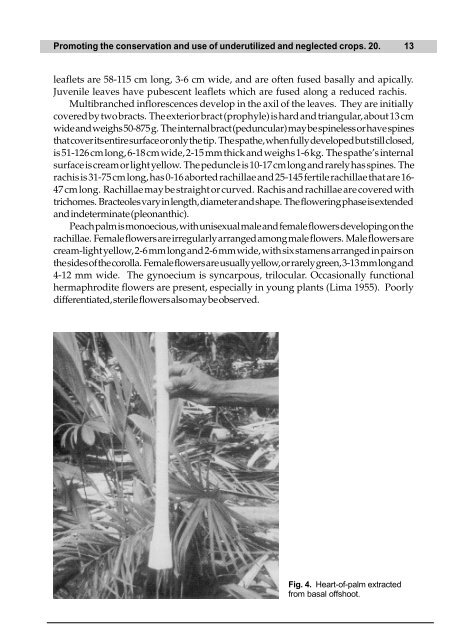Peach palm - World Agroforestry Centre
Peach palm - World Agroforestry Centre
Peach palm - World Agroforestry Centre
Create successful ePaper yourself
Turn your PDF publications into a flip-book with our unique Google optimized e-Paper software.
Promoting the conservation and use of underutilized and neglected crops. 20. 13<br />
leaflets are 58-115 cm long, 3-6 cm wide, and are often fused basally and apically.<br />
Juvenile leaves have pubescent leaflets which are fused along a reduced rachis.<br />
Multibranched inflorescences develop in the axil of the leaves. They are initially<br />
covered by two bracts. The exterior bract (prophyle) is hard and triangular, about 13 cm<br />
wide and weighs 50-875 g. The internal bract (peduncular) may be spineless or have spines<br />
that cover its entire surface or only the tip. The spathe, when fully developed but still closed,<br />
is 51-126 cm long, 6-18 cm wide, 2-15 mm thick and weighs 1-6 kg. The spathe’s internal<br />
surface is cream or light yellow. The peduncle is 10-17 cm long and rarely has spines. The<br />
rachis is 31-75 cm long, has 0-16 aborted rachillae and 25-145 fertile rachillae that are 16-<br />
47 cm long. Rachillae may be straight or curved. Rachis and rachillae are covered with<br />
trichomes. Bracteoles vary in length, diameter and shape. The flowering phase is extended<br />
and indeterminate (pleonanthic).<br />
<strong>Peach</strong> <strong>palm</strong> is monoecious, with unisexual male and female flowers developing on the<br />
rachillae. Female flowers are irregularly arranged among male flowers. Male flowers are<br />
cream-light yellow, 2-6 mm long and 2-6 mm wide, with six stamens arranged in pairs on<br />
the sides of the corolla. Female flowers are usually yellow, or rarely green, 3-13 mm long and<br />
4-12 mm wide. The gynoecium is syncarpous, trilocular. Occasionally functional<br />
hermaphrodite flowers are present, especially in young plants (Lima 1955). Poorly<br />
differentiated, sterile flowers also may be observed.<br />
Fig. 4. Heart-of-<strong>palm</strong> extracted<br />
from basal offshoot.

















